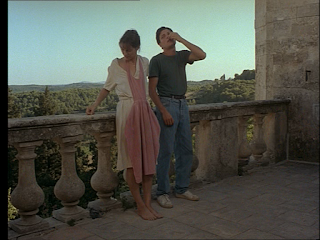Danièle Huillet & Jean-Marie Straub's "Une visite au Louvre" (2004)
Here is the voice-over we listen to over the image above (Paolo Veronese's Marriage at Cana) in Danièle Huillet & Jean-Marie Straub's Une visite au Louvre. The text, titled Le Louvre, is from Joachim Gasquet's monograph Cézanne. It is based on a visit Gasquet made to the Louvre Museum with his friend Cézanne. So, more or less, this is Gasquet's reminiscences of what Cézanne had to say about the painting. First the English translation (thanks to Sally Shafto), then my French transcription (hopefully as read in the film). The French sounds much more musical, and prophetic:
"But here we have painting. There’s painting for you. Detail, ensemble, volumes, values, composition, excitement, it’s all there . . . Believe me, it’s amazing! . . . What’s happening? . . . Shut your eyes, wait, don’t you think of anything. Now open them . . . What about that? . . . One sees only a great coloured undulation, isn’t that right? A rainbow effect, colours, a wealth of colours. That’s the first thing a picture should give us, a harmonious warmth, an abyss into which the eye plunges, something dimly forming. A state of grace induced by colour. You can feel all these shades of colour running in your blood, don’t you agree? You feel reinvigorated. You are born into the true world. You become yourself, you become part of painting . . . To love a painting you need first to have drunk it in like this, in long draughts. You must lose consciousness. Go down with the painter to the dark, tangled roots of things and rise up again from them with the colours, open up with them in the light. Learn how to see. To feel [ . . . ] My word, there was a happy man. And he brings happiness to everyone who understands him. [ . . . ] People and things pass into his consciousness through the sun, with nothing in him separating them from the light, without a sketch, without abstractions, everything in colour. In time they emerge, still the same but somehow clothed in a gentle glory. Happy as if they had inhaled a mysterious music."
"Mais voila de la peinture, voila de la peinture! Le morceau, l'ensemble, les volumes, les valeurs, la composition, le frisson, tout y est. Ecoutez un peu, c'est épatant. Qu'est-ce que nous sommes? Fermez les yeux, attendez, ne pensez plus à rien. Ouvrez-les. N'est-ce pas, on n’aperçoit qu’une grande ondulation colorée, une irisation... Des couleurs, une richesse de couleurs. C'est ça que doit nous donner d'abord le tableau, une chaleur harmonieuse. Un abime où l'œil s'enfonce, une sourde germination, un état de grâce coloré. Tous ces tons vous coulent dans le sang, n'est-ce pas? On se sent ravigoté. On est au monde vrai, on devient soi-même, on devient de la peinture. Pour aimer un tableau il faut d'abord l'avoir bu, ainsi, à longs traits, perdre conscience. Descendre avec le peintre aux racines sombres enchevêtrées des choses. En remonter avec les couleurs, s'épanouir à la lumière, avec elle. Savoir voir, sentir. Celui-là il était heureux, et tous ceux qui le comprennent il les rend heureux. Les choses, les êtres lui entraient dans l'âme avec le soleil sans rien qui les lui sépare de la lumière. Sans desseins, sans abstractions, tout en couleur. Ils en sortaient un jour les mêmes mais on ne sait pourquoi habillé d'une gloire douce tout heureux. Comme s'ils avaient respiré une mystérieuse musique."
Sally Shafto 's full English transcription of the film can be found here. And her article about the film is here. Here is the painting in better resolution.


Comments